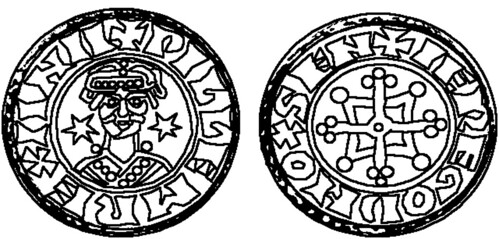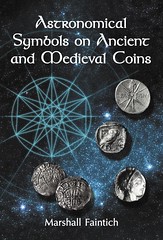
PREV ARTICLE
NEXT ARTICLE
FULL ISSUE
PREV FULL ISSUE
BOOK REVIEW: ASTRONOMICAL SYMBOLS ON ANCIENT & MEDIEVAL COINS
With permission from editor John Mulhall, we are republishing Kerry Rodgers' review of Marshall Fainich's book, "Astronomical Symbols on Ancient & Medieval Coins ", which appeared in the December-January issue of Australasian Coin & Banknote Magazine. Thanks, all!
-Editor
His work explores the notion that many astronomical symbols used on ancient coins record actual celestial events. The study is predicated on the use of coins by monarchs as a propaganda tool, one they used to demonstrate their divine right to rule. Marshall is well placed to make such an analysis. He is, "an astronomer by training, a cartographer by trade, and a student of numismatics, archaeology, and history". His numismatic experience dates back 50 years. The results of his investigation of several hundred ancient coins are illustrated by some 550 line drawings, including maps and records of heavenly events. The first four chapters examine representations on coins of the sun, moon, stars, planets, eclipses and comets, and of the events that may have prompted their incorporation into the coins' designs. Following examination of out-of-left-field astronomical designs and assorted heavenly visions, three chapters look specifically at the coins of Norman England, Anglo-Gallic deniers, and the influence astronomical events held for the crusades, particularly that of Louis IX of France. Both the introduction and the conclusion, that is not a conclusion but rather a beginning, are essential to understanding the rest of the book and Marshall's methodology. First and foremost Marshall is a scientist. He brings to his study the rigour of the scientific method. He well knows that correlation does not imply causation. His approach is spelt out on p. 5: First, the date of a coin bearing an astronomical symbol must be ascertained. Second, the astronomical symbol must be the first occurrence for that coin design or a reintroduction of the symbol after a substantial period of time to rule out immobilization of the design. Third, the occurrence of the astronomical event must be established. Fourth, and most difficult to ascertain, historical evidence must be presented that supports the observance and importance of the event. Much of the remainder of the book is concerned with applying this strategy to a remarkable range of European coins. Each study is something of a mini-detective story. Typical is Marshall's analysis of a well trodden path: the two stars Type V penny of William I. He discounts Carolyn-Britton's interpretation that one star represents a comet of 1077 since no reliable sources identify a comet in that year. There was, however, one in 1075 and he explores that possibility that this is the comet recorded in the coin's design along with that of Halley's in 1066. That latter presaged William's success at Hastings. That of 1075 foretold his triumph over a revolt by English barons. William was no sluggard in exploiting coin designs as instruments of state propaganda. By depicting himself with two comets he declared his right to rule was written in the heavens.

Typical line drawing as used to illustrate a Type V two star silver penny of William I. Image courtesy McFarland & Company and Marshall Faintich. Some analyses are highly detailed such as that of the three heavenly visions experienced by Constantine, a ruler prone to apparitions. I suggest readers ensure they are seated comfortably, have plenty of time to spare, and a goodly supply of coffee to hand before working their way through this one. It is a great yarn that needs careful reading. Of course, you are welcome to disagree. Marshall invites debate. Each and every story is illustrated with clear line drawings, some of coins from Marshall's personal collection. By using such drawings the necessary detail is made clear and presented in a uniform manner. The same result and clarity could not have been achieved from photographs alone. In addition Marshall has used his cartographic skill and astronomical knowledge to bring us maps of the night sky for the appropriate dates. A typical example if that of the planetary alignment on 27 October 312 when Constantine beheld the first of his fiery crosses. This is a book not be to read in a hurry. It is one to be savoured and digested at leisure. It makes no claims to be definitive. It simply represents the current state of play in Marshall's thinking after many years of collecting and analysis. It was preceded by a couple of earlier, shorter books on the subject. Hopefully a further is in the offing.
Readers can obtain copies for US$55 plus p&p., from the publisher, McFarland & Company Inc, Box 611, Jefferson NC 28640, USA or email: info@mcfarlandpub.com or buy directly for the website
www.mcfarlandpub.com
The Numismatic Bibliomania Society is a non-profit organization promoting numismatic literature. See our web site at coinbooks.org. To submit items for publication in The E-Sylum, write to the Editor at this address: whomren@gmail.com To subscribe go to: https://my.binhost.com/lists/listinfo/esylum All Rights Reserved. NBS Home Page Contact the NBS webmaster 
|
